A Wader Spectacular Tour today, in NW Norfolk. It was mostly cloudy and grey this morning, and rather cool, but it did stay largely dry and we did have one or two brighter intervals, more so in the afternoon.
It was an early start to get up to the Wash ahead of high tide this morning. As we arrived on the seawall at Snettisham, we were in good time and there was still a lot of exposed mud. The waders were already gathering – we could see several large streaks of dark out in the middle, huge flocks of Knot and a mass of Oystercatchers.
There were more waders gathering on the mud up towards the sailing club. We got them in the scope – a large flock of Bar-tailed Godwits with a few Knot mixed in, and another smaller group of black-and-white Oystercatchers beyond. There were lots of terns up here too – a mixed flock of Sandwich Terns, larger with a shaggy black crest, Common Terns, smaller and more streamlined with a slicked back black crown.
We hadn’t been there long when something spooked the flocks of Knot out in the middle and they all took to the air. They made some impressive shapes as they swirled across the mud and out over the water beyond. We looked up to see a Peregrine disappearing off high south, inland. It looked like it might have been carrying something in its talons.
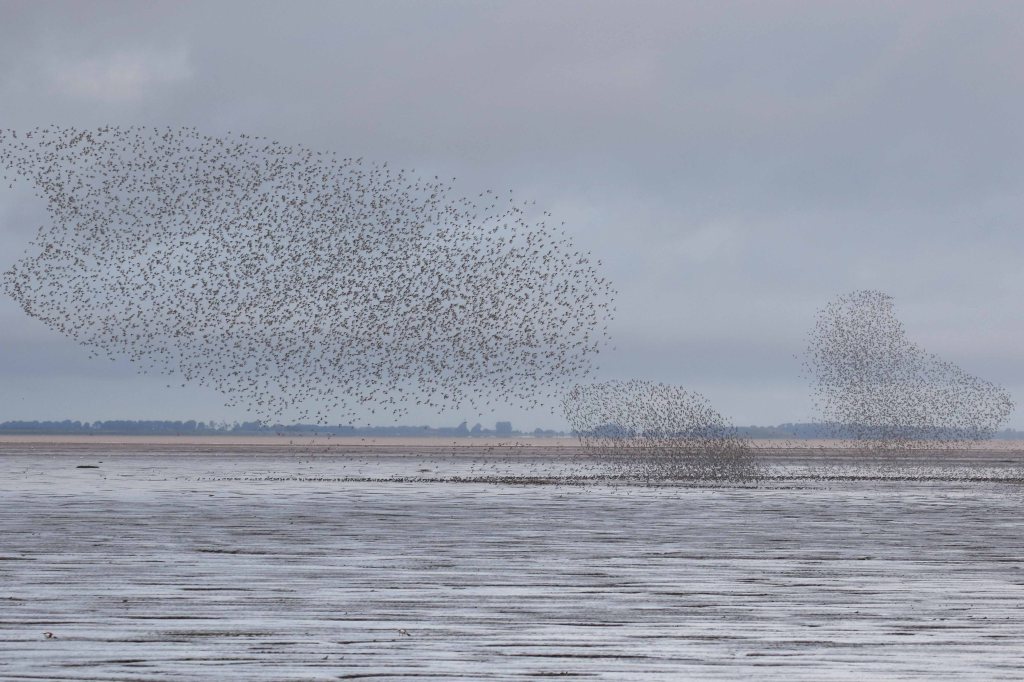
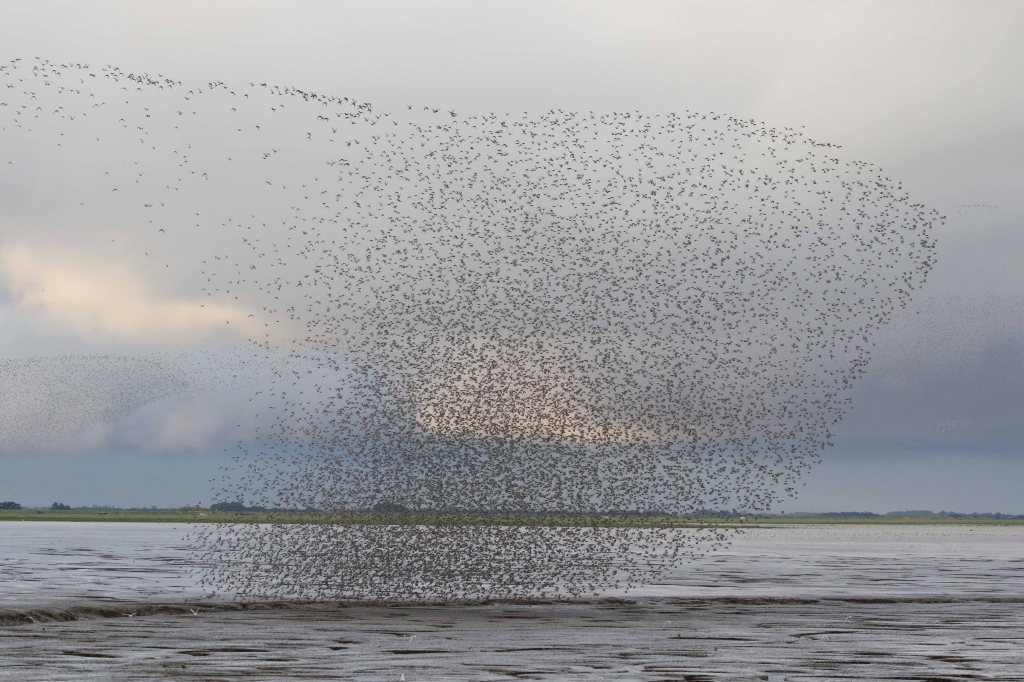
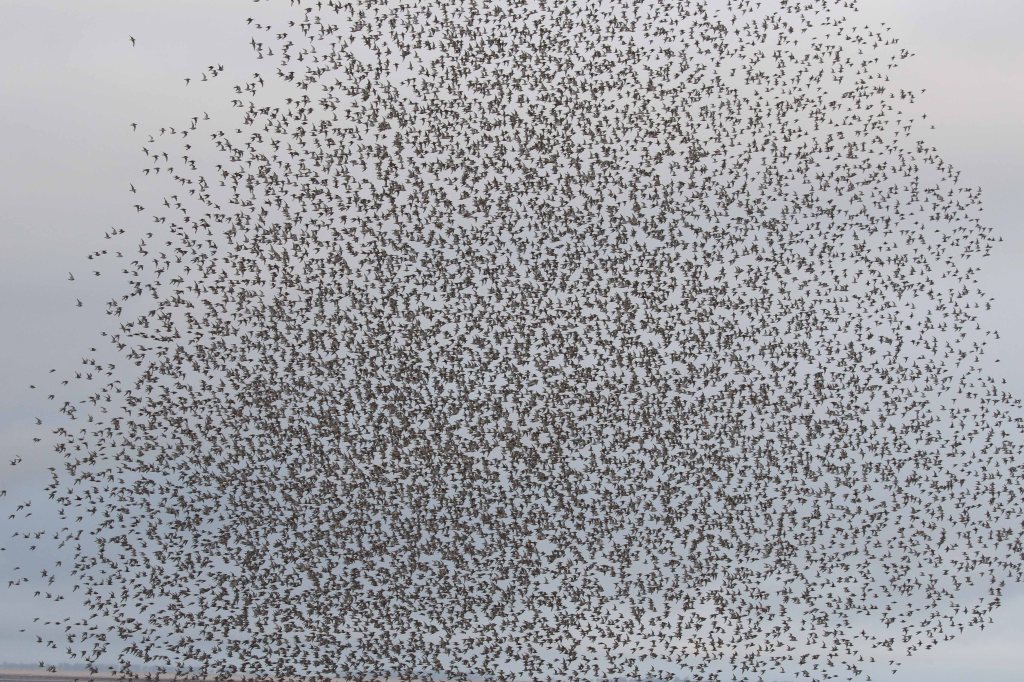
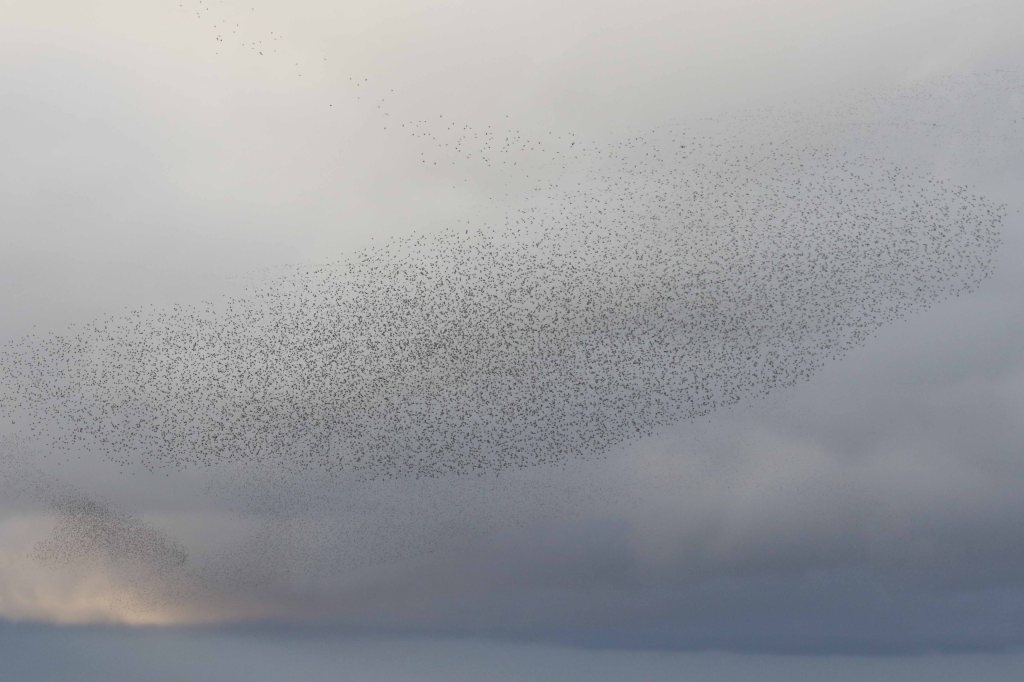
There was a nice selection of smaller waders around the pools closer to us, lots of Ringed Plover and Dunlin, several Turnstones including one still in smart breeding plumage, a few paler silvery-grey and white Sanderling. A Common Snipe flew in and dropped down onto the rocks right in front of us – an odd place to see this species. It crouched down nervously for a bit before the water started to cover the rocks and it flew off again.
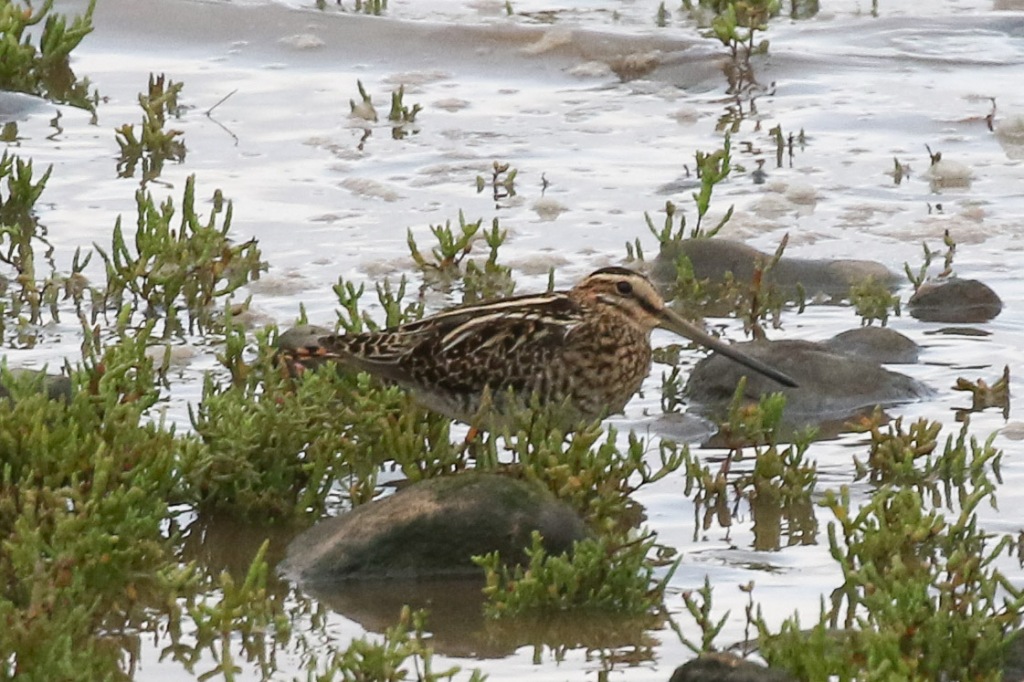
The waders and terns from up by the sailing club slowly peeled off in groups and flew past us, landing again higher up ahead of the rising tide. Before we knew it, all the mud in front of us was covered by the sea, so we made our way down towards Rotary Hide, where there was still lots of exposed mud.
The Knot on the watery edge of the huge masses fly up in flocks, over the others, to escape from the rising tide. In contrast the Oystercatchers walk away from the water – it is always one of the favourite moments, watching the ‘March of the Oystercatchers’, with the whole flock appearing to flow away from the rising tide like one amorphous whole.
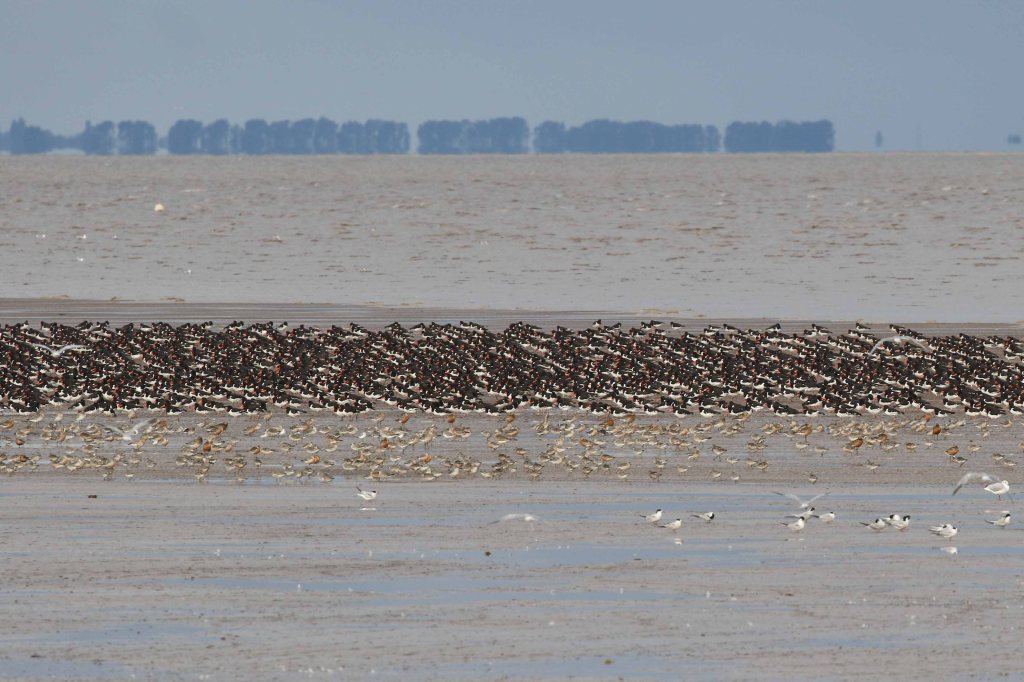
Pretty soon, we had to move on again, down to the shore opposite the SW corner of the mud where everyone was now gathered to watch the climax of the spectacle. The waders were increasingly packed into the last remaining corner of mud. Some of the Oystercatchers started to peel off in groups and fly in past us, piping noisily, dropping down onto the Pit behind us to roost. Five Egyptian Geese flew in over the Wash too.
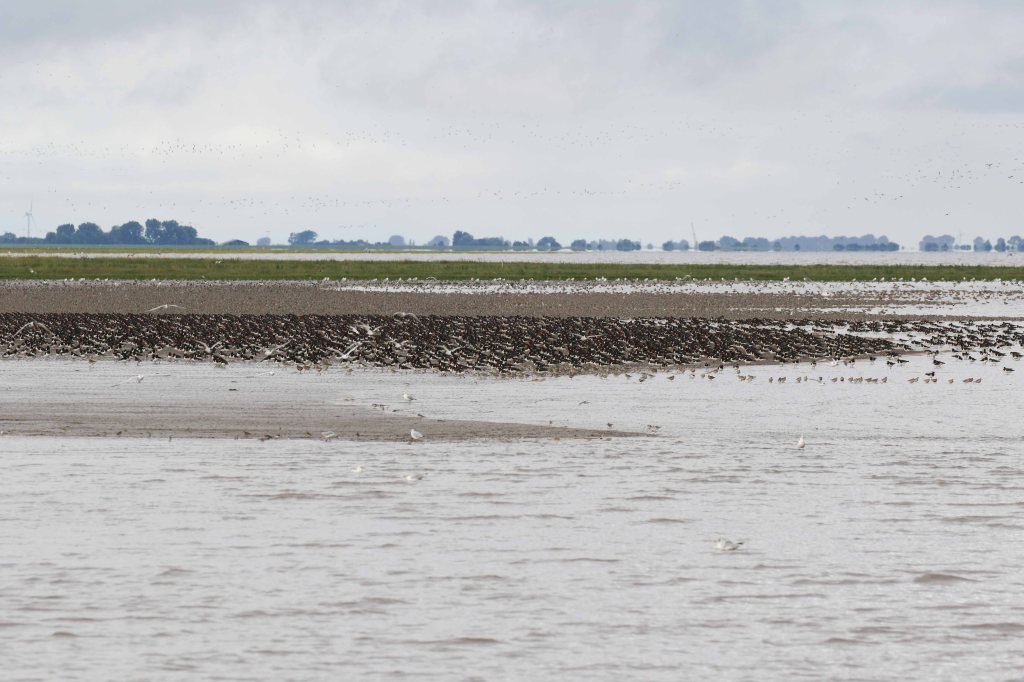
Eventually, it became too much for the Knot, packed in too tight now with the tide rising under them and no more dry mud left to retreat to. Suddenly they erupted. A huge flock took to the air, tens of thousands of birds and turned towards us. They came in low overhead, the sky darkening noticeably, all we could do was look up in awe and listen to the beating of thousands of pairs of wings above us. Mesmerising!
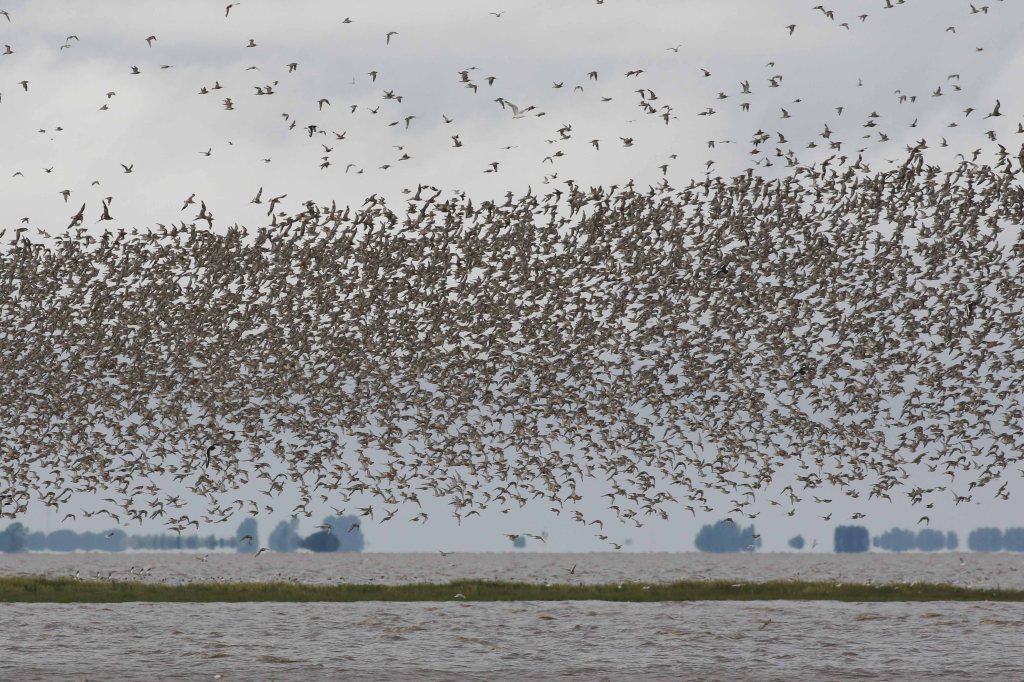
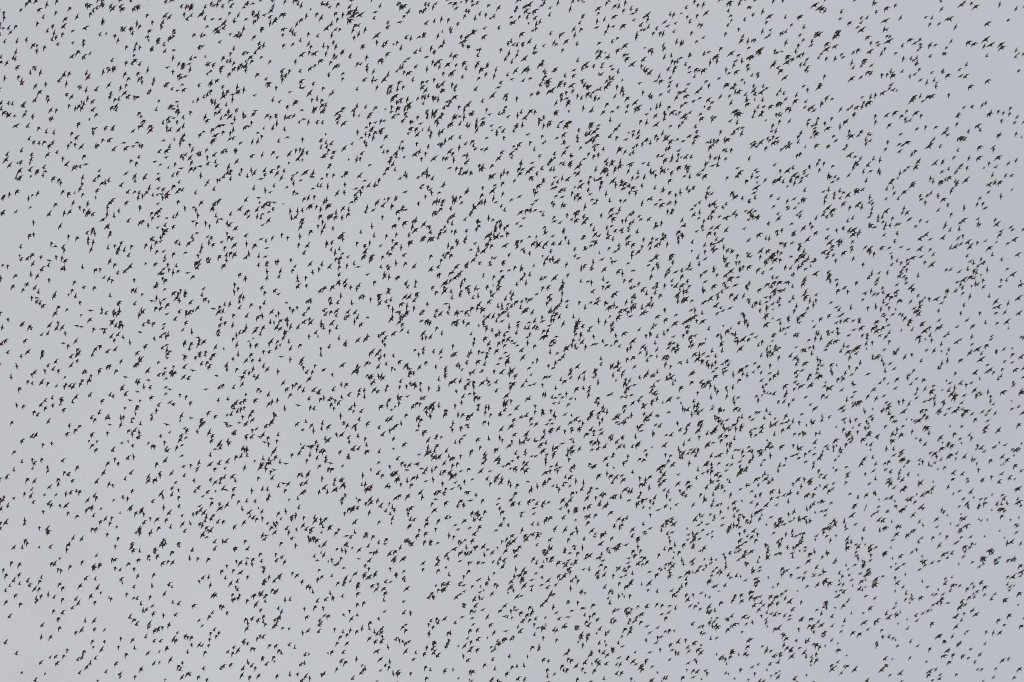
The Knot swirled over the Pit behind us, lines dropping down from the bottom of the flocks as if pulled down by some invisible suction force, down onto the islands on the Pit to roost. The others circled round above to await a clear line of descent. It was obviously filling up fast down on the ground, as several flocks turned back out over the Wash and towered up high into the sky.
A lot of people made a dash for the hides now, but we stayed out on the shore to watch. Another huge wave of Knot came up from the mud in the corner and came in overhead, under the birds which were heading back out, several flocks each thousands of birds strong heading in different directions at different levels above us. There was no room left on the islands in the Pit now and the Knot flew higher and higher, back and forth, out over the Wash. Perhaps they would have to stay airborne over high tide, if they couldn’t find anywhere to land, burning significant amounts of energy in the process.
There were lots of Shelduck out on the water. Four Avocets appeared, bobbing on the water near them. They can swim, but it is not normally something you would expect to see, Avocets swimming past out on the Wash. A distant Gannet flew north out to sea.
We had waited for the initial rush into the hides to die down, before we headed over to Shore Hide, but we still couldn’t get in at first. All the Knot were concentrated on a couple of the smaller islands further up the Pit today, with none now down on the south end, on the islands in front of the new hide, Knot’s Landing. As a consequence, all the photographers had taken up occupation of Shore Hide, filling all the benches facing the birds and the standing room behind, and were obviously not going to move for the duration in case they miss a shot. There was not much room for anyone else. We stood outside for a bit and looked from there.
When most of the non-photographers had come out of the hide, we were able finally to get in, although it still wasn’t easy to find an angle to get the scope on the islands to the north. We scanned the rest of the Pit first. There were seven Spotted Redshanks roosting on the rocks amongst the Cormorants. The whole of the back shore was lined with Black-tailed Godwits and the shingle banks either side over towards Knot’s Landing were covered with Oystercatchers.
Very few birds normally roost on the island right in front of Shore Hide, probably due to the disturbance caused by people in the hide, and today it was completely empty for most of the time. A few Dunlin landed on the far end at one point and a Common Sandpiper picked its way down along the shore for a few minutes, giving us some great views through the scope, before flying off again.
When we could eventually get the scope on the islands where the Knot were roosting, we could see they were packed in very tight today. By this stage of the tide, they have normally finished shuffling and settled down to sleep. Today they were endlessly moving, waves moving through right and left as they jostled for position. No wonder thousands had to turn back out over the Wash.
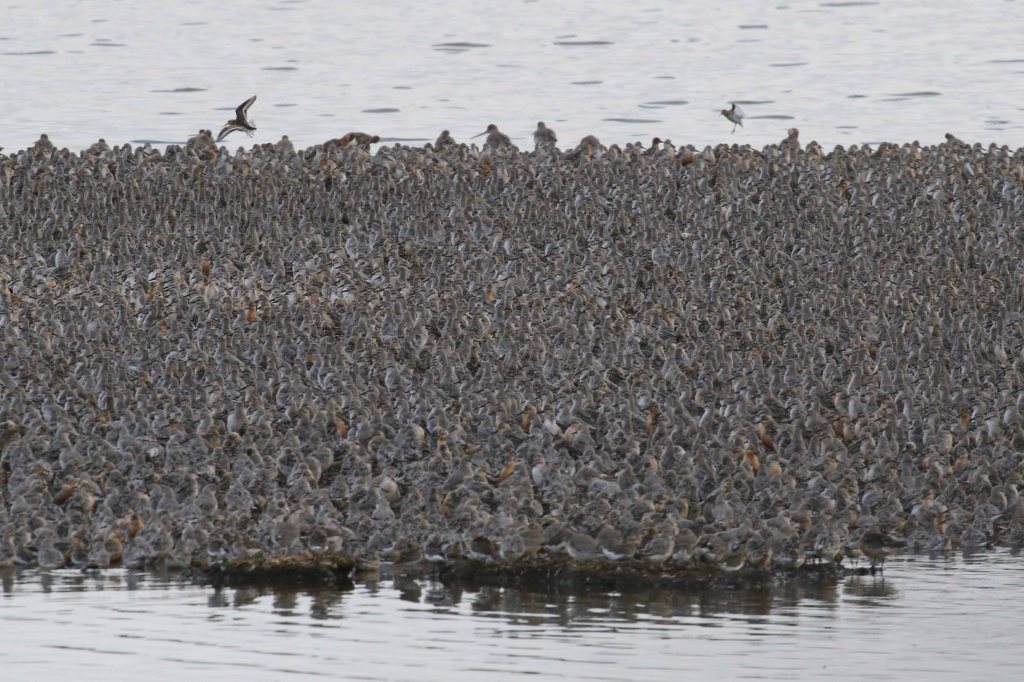
We decided to head back out to the Wash and let someone else have a turn. The tide was already falling and it wasn’t long before the Knot starting to come out from the Pit in lines, over the bank and out over the water.
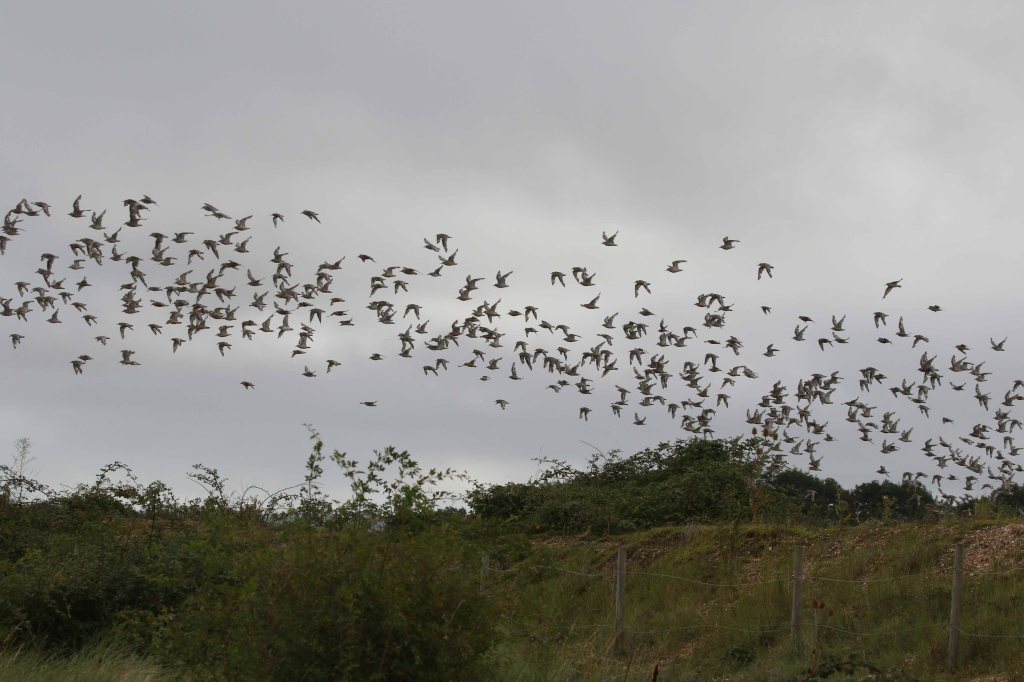
The first Knot probably came out a bit early and there was nowhere for them to go. It wasn’t long though before the tide started falling and the mud began to reappear. The early groups packed back into the corner, but as the amount of exposed myd grew steadily the waders started to space out. Now we could get a look through them, and we picked out a long line of still mostly black-bellied Grey Plovers which had roosted out on the saltmarsh. Three Little Terns appeared out on the mud too and a Mediterranean Gull dropped in.
We could see a Peregrine perched on one of the posts out on the saltmarsh, beyond the mud. It seemed to be waiting for its moment, possibly for the waders to spread out more. Then finally we saw it take off, dropping down and coming in fast and low over the saltmarsh. But the waders saw it coming and erupted again, swirling round out over the mud.
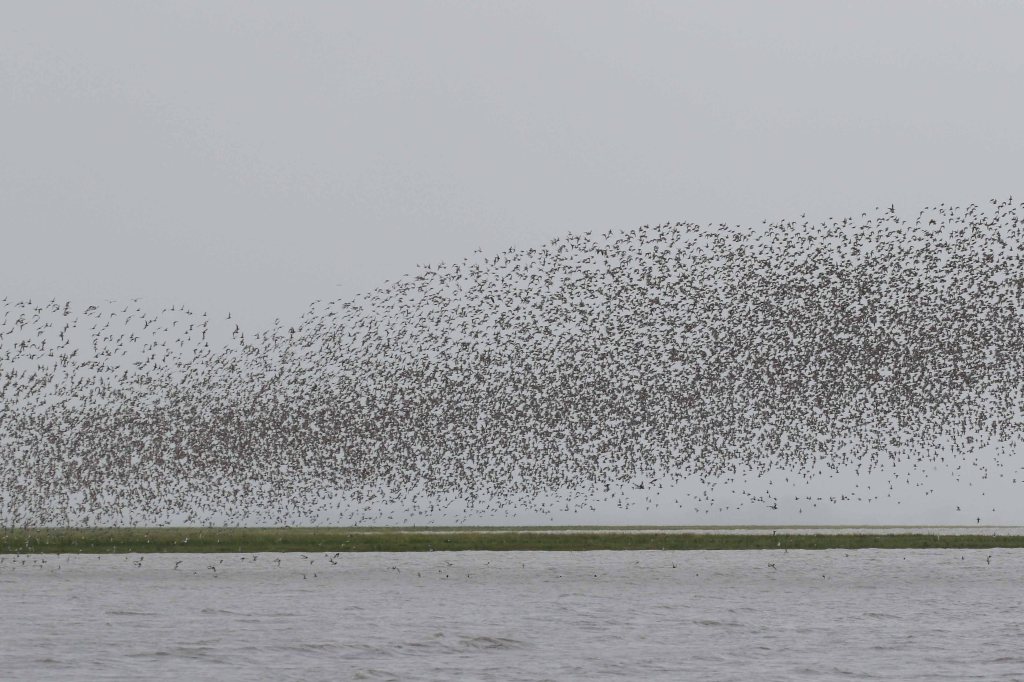
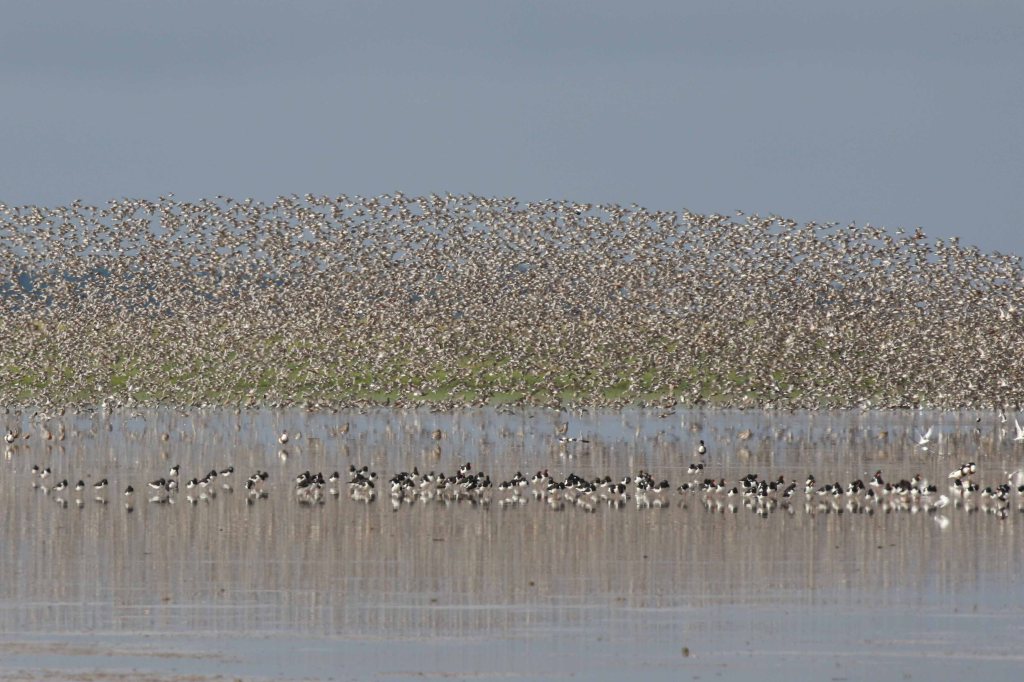
The Peregrine seemed to change its mind now and turned away, heading inland. We watched it chasing Woodpigeons up out of the fields beyond the seawall and over the edge of saltmarsh, stooping repeatedly, before we lost sight of it behind the seawall. The waders slowly settled back down onto the mud.
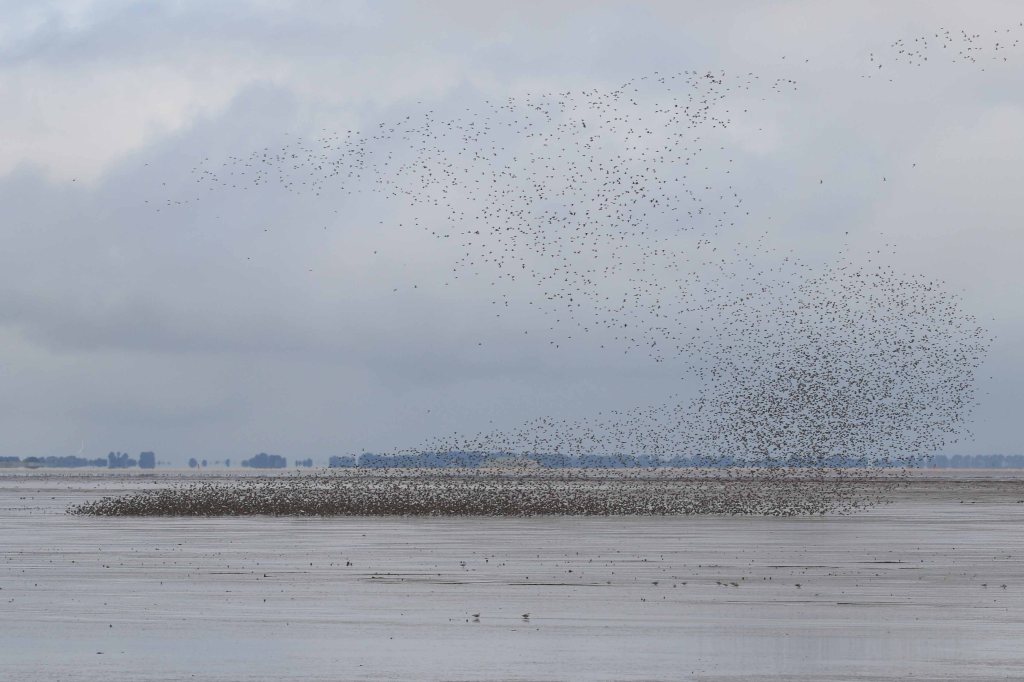
We were just about to leave when one of the volunteers shouted to alert everyone to three Spoonbills flying over the Pit behind us. They looked like they might drop down, disappearing behind the bank, but then climbed again and we could see them heading on north.
Back at Rotary Hide, no one seemed to know anything about a Curlew Sandpiper which had been reported here earlier, so we didn’t stop. A Grey Heron flew out over the mud, briefly spooking the massed flocks of waders again. We continued on further up to look through the small waders which had moved out onto the mud just off the shingle point to feed. Scanning through, we found a Little Stint in with the Dunlin, but unfortunately it disappeared before everyone could get a look at it through the scope.
It had been a great morning at Snettisham, but with the tide receding fast the waders were now getting increasingly distant. We made our way back to the minibus and headed over to Titchwell for an early lunch. After lunch, we headed out for a quick look on the reserve, to see if we could find any more waders. We could hear a tit flock in the willows by the main path so we stopped for a quick look, but couldn’t find anything more unusual with them today. Several Swallows were flying round overhead, a reminder that they are now gathering ahead of their departure for the winter.
As we got out of the trees, a Kestrel was hovering over the bank ahead of us. We stopped for a quick look at the reedbed pool, just as two Bearded Tits flew across at the back. Several Tufted Ducks and a single Common Pochard were additions to the days list, although not looking at their best at this time of year, like most of the other ducks, with the drakes in drab eclipse plumage. Several Reed Warblers zipped back and forth across the ditch in the reeds just beyond the pool.
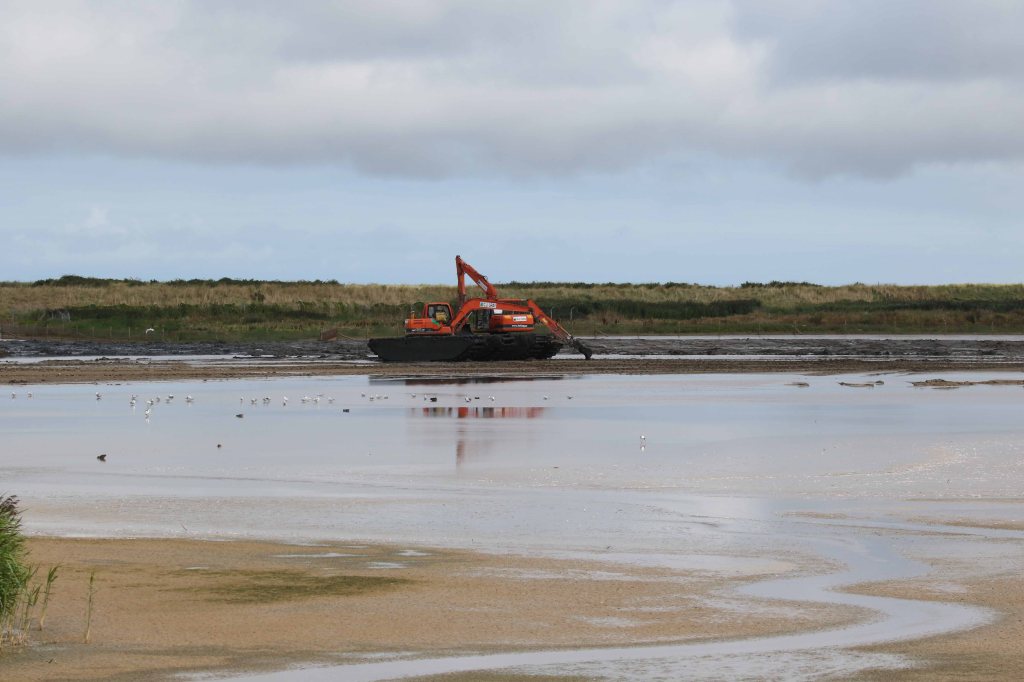
The diggers are still out on the Freshmarsh, as the project to redesign and reprofile the scrape into three separate units continues. Thankfully it doesn’t appear to be putting off the birds – the shallow water was full of waders. We called in at Island Hide, where we scanned through the hundreds of Avocets and Black-tailed Godwits. We found several Ruff of various sizes and colours on the mud and a Common Snipe feeding in more suitable habitat than the one we had seen earlier.
There was lots of the mud we couldn’t see from the hide, with new bunds being created by the diggers, so we went out for another scan from up on the West Bank. There had been a Curlew Sandpiper on here earlier but we couldn’t locate it now. When a flock of Dunlin swirled round and dropped in, we thought it might be with them. But looking through, we found a Little Stint instead – a nice bonus, given the one at Snettisham earlier had escaped before everyone could see it. We enjoyed prolonged views of this one through the scope.
There were several Ringed Plovers on the patches of drier mud and looking through from up on the bank we found a single juvenile Little Ringed Plover too. We heard a Spotted Redshank calling, and looked over to see it flying round over the reedbed. It looked like it was dropping down towards the reedbed pool, but came up again, past us on the path, and disappeared out over the saltmarsh.
Lots of Black-headed Gulls were loafing on the piles of mud and in with them we found a couple of Mediterranean Gulls. They have lost their summer black heads now, but still stood out with their white wingtips.
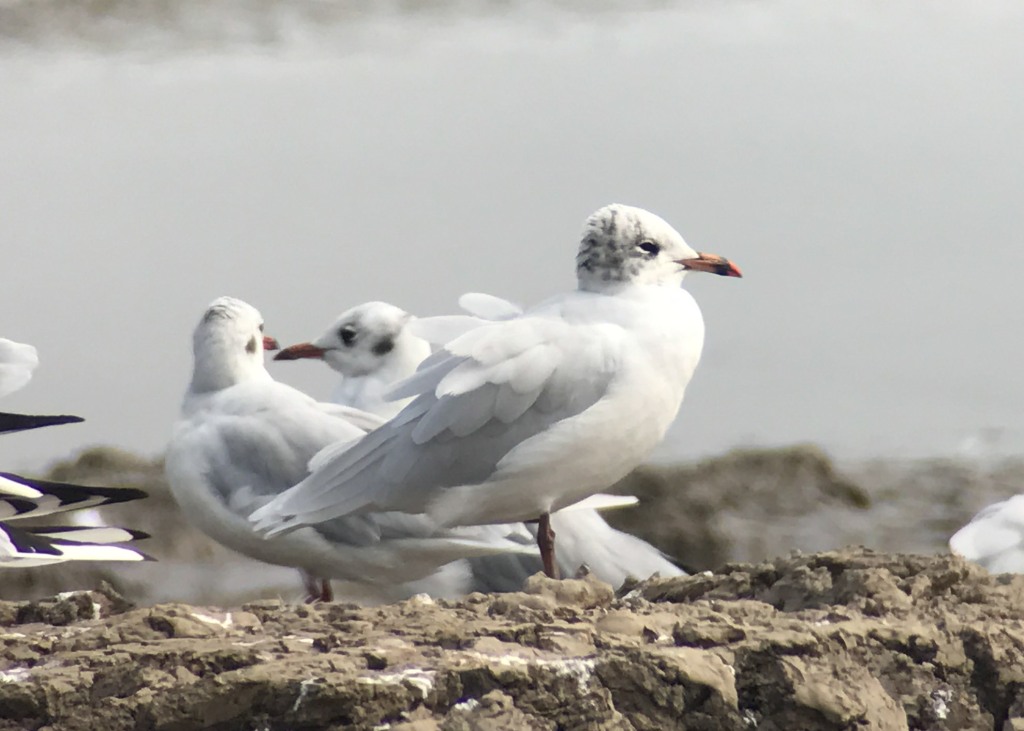
We had a very quick look in Parrinder Hide to see if we could find the Curlew Sandpiper from there, but the far end of the Freshmarsh is not yet done and we couldn’t see much with the old fence of Avcoet Island in the way. There were a few Linnets and Pied Wagtails bathing in the shallow water in front of the hide. As we came back out, we heard the shrill call of a Yellow Wagtail, and looked over the bank just in time to catch the back end of it disappearing off west.
We headed out for a quick look at the sea. The Tidal Pool was surprisingly full of water, given it was now low tide, so presumably it is not draining freely again after the latest big tides. We did find a single Greenshank and a Grey Plover over in the far corner, and a lone Curlew was on one of the islands.
Out on the beach, we scanned the sea but there was nothing moving this afternoon. We could see a selection of waders down on the mussel beds, but nothing we hadn’t seen earlier. We were out of time, so we turned to head back.
Back at the Freshmarsh, we stopped for a last scan. We immediately found a Whimbrel in among the waders towards the back. We were just looking at that when we realised a group further up the path were watching the Curlew Sandpiper. One of the volunteers pointed out where it was, hiding behind a small pile of mud in the water quite close to the path. We turned the scope on it and thankfully after a few seconds it walked out into the open and started feeding in the shallows. A scaly backed juvenile, we could see its long decurved bill through the scope now.
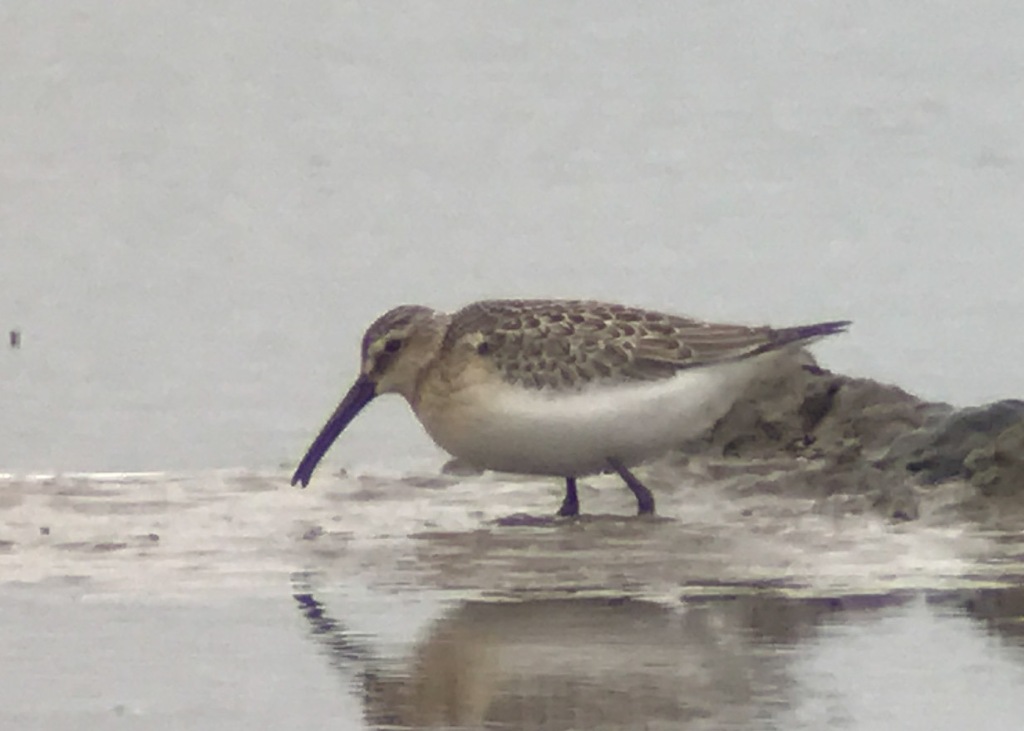
A nice way to end the day, it was now definitely time to head back.
















